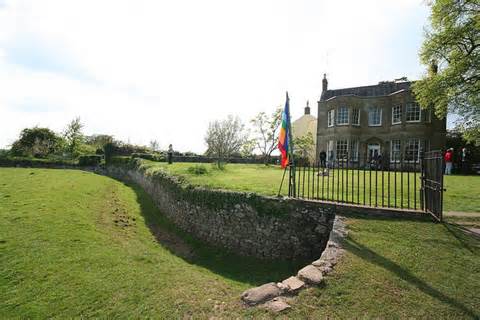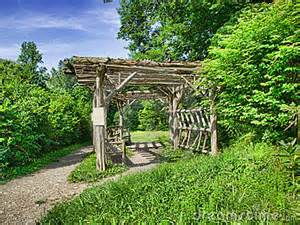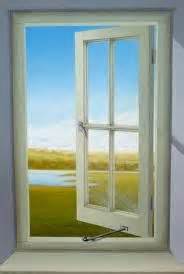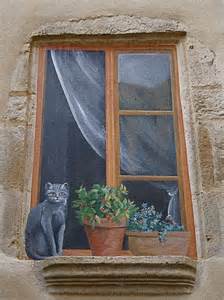
Salty Sam’s Fun Blog for Children
Number 169
Garden Features
Hello Everyone

Since Henry Vlll made the kingdom more secure with one state controlled army, people have been living in houses surrounded by gardens instead of in castles and fortified houses.
This new style of house was called a prodigy (pronounced prodejee) house.
Gardens are places that people have always loved to relax in. Most of the people in Rocky Bay have gardens. Some of the stone cottages in the centre of Rocky Bay only have little courtyard gardens but they are all really well-looked-after and a riot of colour in the summer time.
Gardens are full of trees and flowers, but if people through history have had very large gardens, they have always wanted to put other interesting things in them as well; like statues, fountains and mazes.
The statue at the top of the page is of Peter Pan in Kensington Gardens.
Have you ever been lost in a garden maze? They are made from evergreen hedges and even the tallest of people can’t see over the top of the walls.
Mazes were first thought of as early as 1460 but weren’t really brought to life until the 16th century.
They were a very popular garden feature throughout the 16th, 17th and 18th centuries and are still being planted today. The maze at Longleat House was designed in 1978. Of course, once a maze is planted the hedges take quite a long time to grow.
One of the most famous ones is at Hampton Court Palace. lt is also the oldest surviving garden maze planted in the late 1600s. lt has over half a mile of paths so it will give you a lot of exercise if you get lost!
They say that if you run your right hand along the hedge from the time you go into the entrance, you can be sure to find your way into the middle – although this is not the quickest way there.

Fountains can be small of course, but some of them are astoundingly large. They are often in the middle of large lakes like the famous ones in the gardens of Versailles built in the 18th century. Added to this, were very often vast waterfalls, and the results were spectacular.
These old gardens took a lot time to create because they did not have modern earth-moving machinery or cranes to help them. The enormous lake at Hever Castle was dug by hand by hundreds of unemployed soldiers returning from the Nepoleonic wars.

One feature that garden designers liked to incorporate into 18th century gardens was something called a ha-ha.
No, l’m not laughing, that’s what it was called. ![]()
lt was a little vertical drop at the end of a garden – just high enough to prevent animals beyond, like sheep, from climbing up onto the lawn.
By using a ha-ha, people did not need to build a garden fence at the bottom of their garden, and so had an unobstructed view of the countryside beyond. This is what we call a ‘borrowed landscape’. lt means that the view beyond the garden becomes part of the garden as the two seem to blend together. The ha-ha was often strengthened by a wall so that it would not collapse when you walked near it and sometimes it had a ditch beyond it to act as an additional barrier; neither of these features would be visible from the garden.

There were also arbours which were little shelters built in the garden where people could meet – sometimes secretly. (Not to be confused with harbours where ships dock.)
Sometimes they had seats in them and sometimes they had flowers like rambling roses or honeysuckle growing up their sides so the people sitting on the seat could smell the beautiful fragrances.

Trompe l’oeil is another feature you may not have heard of. The term means trick of the eye. Paintings on walls can look so lifelike that you think you are seeing landscapes that are not there. This feature helps to give a sense of space in small gardens.

The strangest things that people built in their gardens though were follies.
A folly is a building built for decoration rather than use. Although they could be useful of course, if you got caught in a shower of rain and needed somewhere to shelter!
A folly is often placed on a hill so that it can be seen from a long way away, or maybe hidden in the trees so people can happen upon it unexpectedly when they are out walking.
Follies could look like castles, towers, classical temples, ruins, miniature houses or grottos.
Do you have any unusual features in your garden?
Bye bye everyone – don’t forget to subscribe to my blog!
lf you like my blog, please support it by telling all your friends and followers about it.
Thank you!
And see you again next Fun Friday!
Love and kisses
Salty Sam

www.christina-sinclair.com


Bill and Bob’s Joke of the Week![]()
![]()
Bill: What did the waterfall say to the fountain?
Bob: l don’t know. What did the waterfall say to the fountain?
Bill: Hello little squirt!

Salty Sam © Christina Sinclair 2015
Unauthorized use and/or duplication of material from this blog without express and written permission from this blog’s author and owner is strictly prohibited.
Links may be used to www.christina-sinclair.com

Picture Gallery
 Hedges don’t have to just be green – this Forsythia has yellow flowers on it in the spring
Hedges don’t have to just be green – this Forsythia has yellow flowers on it in the spring
 Trees can create taller barriers
Trees can create taller barriers

A Roman style fountain with a shells and dogs’ head design
(The British Museum)
 A prodigy house at Wollaton
A prodigy house at Wollaton
 Hampton Court Maze full of people
Hampton Court Maze full of people
 Hampton Court Maze in the winter
Hampton Court Maze in the winter
 Knot Garden made with little hedges at the Red Lodge Museum, Bristol
Knot Garden made with little hedges at the Red Lodge Museum, Bristol
 The gardens at Versailles in France
The gardens at Versailles in France
A garden like this is designed to be more impressive than restful
 Waterfall Kew Gardens
Waterfall Kew Gardens
 Fountains and lake at Hampton Court Palace
Fountains and lake at Hampton Court Palace

Fountains in Kensington Gardens
 Fountains in Kensington Gardens
Fountains in Kensington Gardens
 Fountains, statues and trees make towns pleasanter too
Fountains, statues and trees make towns pleasanter too
 The lake at Hever Castle in Kent
The lake at Hever Castle in Kent
 A ha-ha
A ha-ha
 An arbour
An arbour
 Trompe l’oeil
Trompe l’oeil
 Trompe l’oeil
Trompe l’oeil
 Trompe l’oeil
Trompe l’oeil
 A folly of classical style
A folly of classical style
 Dryden Tower Folly in Scotland (Victorian)
Dryden Tower Folly in Scotland (Victorian)
 Dinton Folly in Aylesbury
Dinton Folly in Aylesbury
 Pontypool Folly
Pontypool Folly
 A garden flower clock
A garden flower clock
It is a large clock mechanism set in the ground that does work – and plants are planted on top of it
 A garden planter on a plinth (pillar) (Hyde Park)
A garden planter on a plinth (pillar) (Hyde Park)
 Topiary is the art of shaping plants into shapes, people or creatures (Beckley Park)
Topiary is the art of shaping plants into shapes, people or creatures (Beckley Park)
 Topiary at Greenwich on a very hot day
Topiary at Greenwich on a very hot day
 In the late 1700s and the early 1800s houses were very symmetrical and their gardens were designed to match
In the late 1700s and the early 1800s houses were very symmetrical and their gardens were designed to match
 These planters are called Versailles boxes
These planters are called Versailles boxes
 Japanese gardens have raked gravel denoting the ripples on water (Kew Gardens)
Japanese gardens have raked gravel denoting the ripples on water (Kew Gardens)

Park benches are a nice place to rest and watch the world go by
This robin certainly thinks so
 A court yard fountain at Hampton Court Palace
A court yard fountain at Hampton Court Palace
 A garden fountain in The Privy Garden at Hampton Court Palace
A garden fountain in The Privy Garden at Hampton Court Palace
 These yew trees in The Great Fountain Garden at Hampton Court Palace
These yew trees in The Great Fountain Garden at Hampton Court Palace
are clipped to give them a spectacular shape
 A flower bed in a lawn is called an island bed – one of these has a palm tree in it too
A flower bed in a lawn is called an island bed – one of these has a palm tree in it too
 A flower bed against a wall is called a border
A flower bed against a wall is called a border
 This is a knot garden at Hampton Court Palace
This is a knot garden at Hampton Court Palace
The plants are put into patterns
 Sunken gardens are sheltered and become warm ‘sun traps’
Sunken gardens are sheltered and become warm ‘sun traps’
(The Pond Garden at Hampton Court Palace)
 Hedges can protect a garden from wind
Hedges can protect a garden from wind
 Hedges made out of box trees can be clipped to make them have very flat tops and sides
Hedges made out of box trees can be clipped to make them have very flat tops and sides
 A statue with a classical style
A statue with a classical style
(The Great Fountain Garden at Hampton Court Palace)
 Upright trees give a sense of energy to a garden like punctuation marks
Upright trees give a sense of energy to a garden like punctuation marks
 Horizontal lines in a garden give a feeling of restfulness
Horizontal lines in a garden give a feeling of restfulness
 Walls can be made into a garden feature
Walls can be made into a garden feature
 A Victorian greenhouse (Geffrye Museum)
A Victorian greenhouse (Geffrye Museum)
 An arbour can be used to support climbing plants – and for secret meetings!
An arbour can be used to support climbing plants – and for secret meetings!
 Container grown plants can be quite big
Container grown plants can be quite big
 Container grown plants can be kept in gardens without any soil
Container grown plants can be kept in gardens without any soil

Garden gnomes are a relatively modern garden feature


 THE SALTY SAM NEWS DESK
THE SALTY SAM NEWS DESK

Quite recently, we all went to visit my cousin Smiley Sid in London, and Bill and Bob wanted to see the statue of Peter Pan in Kensington Gardens.
Peter Pan is one of their favourite stories.
It is made of bronze, which is a kind of valuable metal, and was unveiled on 1st May 1912, so it has been there quite a long time.
I noticed that there were little mice on the statue just like my lighthouse mice, and there were rabbits too just like the ones that live in the sand dunes of Sandy Cove!
There was a folly in the gardens as well. It was a good place to shelter from the rain.




Kensington Gardens


*********************
TO ADVERTISE ON THIS BLOG
PLEASE CONTACT:
christina.sinclair.ads@aol.co.uk
*********************


Quick Quiz
Which countries have these flowers as their national flowers?
- Golden wattle
- lris
- Lily-of-the valley
- Daffodil
- Tulip
- Lavender
- Thistle
- Red carnation
- Rose
- Lotus


BLOW MY FOGHORN!!!

PLUS
Salty Sam fans can join in with their comments and share them with children all over the world. You will need to ask permission if you are not an adult.
Enter your e-mail address to subscribe to my blog and receive new Salty Sam Blog Posts for free by e-mail every week. Your address will be kept private and will not be shared with any third party.
Sign me up at the side bar




lt’s the Weekend!

HOW TO MAKE A MAZE GAME
You will need:
A sheet of graph paper
Colouring pencils
Some card or paper cut into question cards about the size of playing cards
A small plastic cup
A die
A narrow box for propping your question cards up in (or you can pile the cards on the table question side up)
- Take a sheet of graph paper and draw a maze on it.
- Number the squares on the path you need to take through the maze – make sure that the squares are big enough to place counters on.
- Make plenty of cards and write general knowledge questions on the front and the answers on the back. Prop them up in a narrow box so that you can’t see the backs of the cards when you pick them up to read them.
- Each player can write some cards and then let the other players answer the questions or you can shuffle the cards together into one deck (and hope you get lots of your own
 ).
). - Throw a die only when you know that you have answered a question correctly.
- If you throw the die, use the number you throw to know how many squares you can move forward.
- The first person to get through the maze wins – any number of people can play.
- Your board could look something like this…
Click on the link for the PDF…
Here are some questions to start you off…

- What colour is vermillion?
- What is the capital city of Italy?
- What kind of animal was Bambi?
- What is a baby goat called?
- What colour is a lime?
- What is cheese made from?
- Who wrote Winnie the Pooh?
- Which tree produces conkers?
- Which planet is closest to the Sun?
- Where does the Queen live when she is in London?

Please note that the material on this blog is for personal use and for use in classrooms only.
It is a copyright infringement and, therefore, illegal under international law to sell items made with these patterns.
Use of the toys and projects is at your own risk.
©Christina Sinclair Designs 2015


Quick Quiz Answers
- Golden wattle – Australia
- lris – France
- Lily-of-the valley – Finland and Yugoslavia
- Daffodil – Wales
- Tulip _ Holland and Hungary
- Lavender – Portugal
- Thistle – Scotland
- Red carnation – Spain
- Rose – England
- Lotus – lndia

Golden wattle

Iris

Lily of the Valley

Thistle

Carnation

Lotus flower

MAZE GAME ANSWERS
- What colour is vermillion? – red
- What is the capital city of Italy? – Rome
- What kind of animal was Bambi? – a deer
- What is a baby goat called? – a kid
- What colour is a lime? – green
- What is cheese made from? – milk
- Who wrote Winnie the Pooh? – A. A. Milne
- Which tree produces conkers? – a horse chestnut
- Which planet is closest to the Sun? – Mercury
- Where does the Queen live when she is in London? – Buckingham Palace



